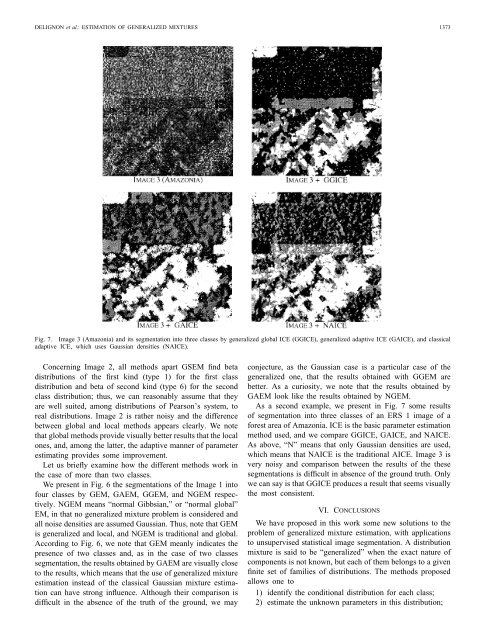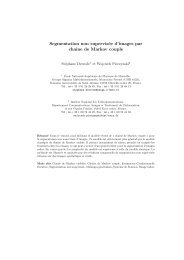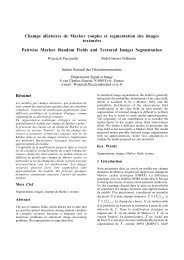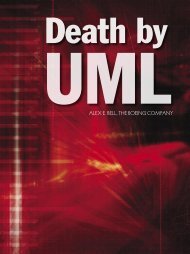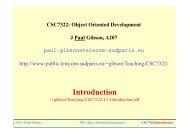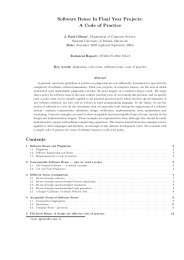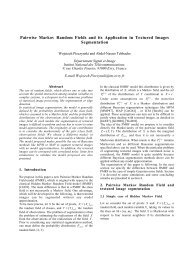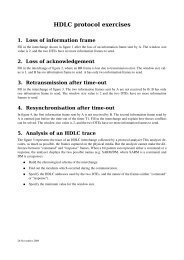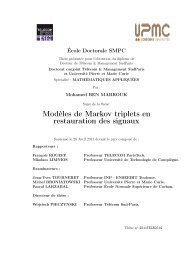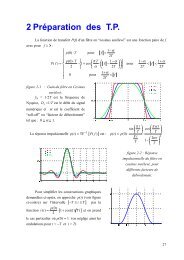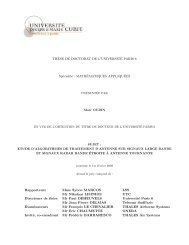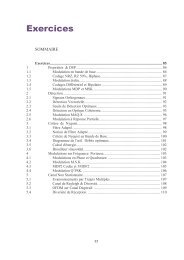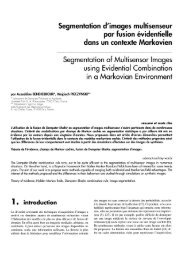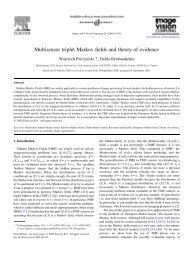DELIGNON et al.: ESTIMATION OF GENERALIZED MIXTURES 1373Fig. 7. Image 3 (Amazonia) and its segmentation into three classes by generalized global ICE (GGICE), generalized adaptive ICE (GAICE), and classicaladaptive ICE, which uses Gaussian densities (NAICE).Concerning Image 2, all methods apart GSEM find betadistributions of the first kind (type 1) for the first classdistribution and beta of second kind (type 6) for the secondclass distribution; thus, we can reasonably assume that theyare well suited, among distributions of Pearson’s system, toreal distributions. Image 2 is rather noisy and the differencebetween global and local methods appears clearly. We notethat global methods provide visually better results that the localones, and, among the latter, the adaptive manner of parameterestimating provides some improvement.Let us briefly examine how the different methods work inthe case of more than two classes.We present in Fig. 6 the segmentations of the Image 1 intofour classes by GEM, GAEM, GGEM, and NGEM respectively.NGEM means “normal Gibbsian,” or “normal global”EM, in that no generalized mixture problem is considered andall noise densities are assumed Gaussian. Thus, note that GEMis generalized and local, and NGEM is traditional and global.According to Fig. 6, we note that GEM meanly indicates thepresence of two classes and, as in the case of two classessegmentation, the results obtained by GAEM are visually closeto the results, which means that the use of generalized mixtureestimation instead of the classical Gaussian mixture estimationcan have strong influence. Although their comparison isdifficult in the absence of the truth of the ground, we mayconjecture, as the Gaussian case is a particular case of thegeneralized one, that the results obtained with GGEM arebetter. As a curiosity, we note that the results obtained byGAEM look like the results obtained by NGEM.As a second example, we present in Fig. 7 some resultsof segmentation into three classes of an ERS 1 image of aforest area of Amazonia. ICE is the basic parameter estimationmethod used, and we compare GGICE, GAICE, and NAICE.As above, “N” means that only Gaussian densities are used,which means that NAICE is the traditional AICE. Image 3 isvery noisy and comparison between the results of the thesesegmentations is difficult in absence of the ground truth. Onlywe can say is that GGICE produces a result that seems visuallythe most consistent.VI. CONCLUSIONSWe have proposed in this work some new solutions to theproblem of generalized mixture estimation, with applicationsto unsupervised statistical image segmentation. A distributionmixture is said to be “generalized” when the exact nature ofcomponents is not known, but each of them belongs to a givenfinite set of families of distributions. The methods proposedallows one to1) identify the conditional distribution for each class;2) estimate the unknown parameters in this distribution;
1374 <strong>IEEE</strong> TRANSACTIONS ON IMAGE PROCESSING, VOL. 6, NO. 10, OCTOBER 19973) estimate priors;4) estimate the “true” class image.Assuming that each of unknown noise probability distributionis in the Pearson system, our methods are based onmerging two approaches of classical problems. On the onehand, we use classical mixture estimation methods like EM[5], [9], [31], SEM [24], [26], or ICE [3], [4], [26]–[28].On the other hand, we use the fact that if we know that thesample considered proceeds from one family in the Pearsonsystem, we dispose of decision rule, based on “skewness” and“kurtosis,” for which family it belongs to. Different algorithmsproposed are then applied to the problem of unsupervisedBayesian image segmentation in a “local” and “global” way.The results of numerical studies of a synthetic image andsome real ones, and other results presented in [22], show theinterest of the generalized mixture estimation in the unsupervisedimage segmentation context. In particular, the mixturecomponents are, in general, correctly estimated.As possibilities for future work, let us mention the possibilityof testing the methods proposed in many problems outsidethe image segmentation context, like handwriting recognition,speech recognition, or any other statistical problem requiringa mixture recognition. Furthermore, it would undoubtedlybe of purpose studying other generalized mixture estimationapproaches, based on different decision rules and allowing oneto leave the Pearson system.ACKNOWLEDGMENTThe image of Fig. 3 was provided by CIRAD SA underthe project GDR ISIS. The authors thank A. Bégué for hercollaboration.REFERENCES[1] R. Azencott, Ed., Simulated Annealing: Parallelization Techniques.New York: Wiley, 1992.[2] J. Besag, “On the statistical analysis of dirty pictures,” J. R. Stat. Soc.B, vol. 48, pp. 259–302, 1986.[3] B. Braathen, W. Pieczynski, and P. Masson, “Global and local methodsof unsuperivsed Bayesian segmentation of images,” Machine Graph.Vis., vol. 2, pp. 39–52, 1993.[4] H. Caillol, W. Pieczynski, and A. Hillon, “<strong>Estimation</strong> of fuzzy Gaussianmixture and unsupervised statistical image segmentation,” <strong>IEEE</strong> Trans.Image Processing, vol. 6, pp. 425–440, 1997.[5] B. Chalmond, “An iterative Gibbsian technique for reconstruction ofm-ary images,” Pattern Recognit., vol. 22, pp. 747–761, 1989.[6] R. Chellapa and R. L. Kashyap, “Digital image restoration using spatialinteraction model,” <strong>IEEE</strong> Trans. Acoust., Speech, Signal Processing, vol.ASSP-30, pp. 461–472, 1982.[7] R. Chellapa and A. Jain, Eds., Markov Random Fields. New York:Academic,1993.[8] Y. Delignon, “Etude statistique d’images radar de la surface de la mer,”Ph.D. dissertation, Université de Rennes I, Rennes, France, 1993.[9] A. P. Dempster, N. M. Laird, and D. B. Rubin, “Maximum likelihoodfrom incomplete data via the EM algorithm,” J. R. Stat. Soc. B, vol. 39,pp. 1–38, 1977.[10] H. Derin and H. Elliot, “Modeling and segmentation of noisy andtextured images using Gibbs random fields,” <strong>IEEE</strong> Trans. Pattern Anal.Machine Intell., vol. 9, pp. 39–55, 1987.[11] P. A. Devijver, “Hidden Markov mesh random field models in imageanalysis,” in Advances in Applied Statistics, Statistics and Images: 1.Abingdon, U.K.: Carfax, 1993, pp. 187–227.[12] R. C. Dubes and A. K. Jain, “Random field models in image analysis,”J. Appl. Stat., vol. 16, 1989.[13] S. Geman and G. Geman, “Stochastic relaxation, Gibbs distributions andthe Bayesian restoration of images,” <strong>IEEE</strong> Trans. Pattern Anal. MachineIntell, vol. PAMI-6, pp. 721–741, 1984.[14] N. Giordana and W. Pieczynski, “<strong>Estimation</strong> of generalized multisensorhidden Markov chains and unsupervised image segmentation,” <strong>IEEE</strong>Trans. Pattern Anal. Machine Intell., vol. 19, pp. 465–475, 1997.[15] X. Guyon, “Champs aléatoires sur un réseau,” in Collection TechniquesStochastiques. Paris, France: Masson, 1993.[16] R. Haralick and J. Hyonam, “A context classifier,” <strong>IEEE</strong> Trans. Geosci.Remote Sensing, vol. GE-24, pp. 997–1007, 1986.[17] N. L. Johnson and S. Kotz, Distributions in Statistics: ContinuousUnivariate Distributions, vol. 1. New York: Wiley, 1970.[18] R. L. Kashyap and R. Chellapa, “<strong>Estimation</strong> and choice of neighborsin spatial-interaction models of images,” <strong>IEEE</strong> Trans. Inform. Theory,vol. 29, pp. 60–72, 1983.[19] P. A. Kelly, H. Derin, and K. D. Hartt, “Adaptive segmentation ofspeckled images using a hierarchical random field model,” <strong>IEEE</strong> Trans.Acoust., Speech, and Signal Processing, vol. 36, pp. 1628–1641, 1988.[20] S. Lakshmanan and H. Herin, “Simultaneous parameter estimationand segmentation of Gibbs random fields,” <strong>IEEE</strong> Trans. Pattern Anal.Machine Intell., vol. 11, pp. 799–813, 1989.[21] J. Marroquin, S. Mitter, and T. Poggio, “Probabilistic solution of illposedproblems in computational vision,” J. Amer. Stat. Assoc., vol. 82,pp. 76–89, 1987.[22] A. Marzouki, “Segmentation statistique d’images radar,” Ph.D. dissertation,Université de Lille I, Lille, France, Nov. 1996.[23] A. Marzouki, Y. Delignon, and W. Pieczynski, “Adaptive segmentationof SAR images,” in Proc. OCEAN ’94, Brest, France.[24] P. Masson and W. Pieczynski, “SEM algorithm and unsupervisedsegmentation of satellite images, <strong>IEEE</strong> Trans. Geosci. Remote Sensing,vol. 31, pp. 618–633, 1993.[25] E. Mohn, N. Hjort, and G. Storvic, “A simulation study of somecontextual clasification methods for remotely sensed data,” <strong>IEEE</strong> Trans.Geosci. Remote Sensing, vol. GE-25, pp. 796–804, 1987.[26] A. Peng and W. Pieczynski, “Adaptive mixture estimation and unsupervisedlocal Bayesian image segmentation,” Graph. Models ImageProcessing, vol. 57, pp. 389–399, 1995.[27] W. Pieczynski, “Mixture of distributions, Markov random fields andunsupervised Bayesian segmentation of images,” Tech. Rep. no. 122,L.S.T.A., Université Paris VI, Paris, France, 1990.[28] , “Statistical image segmentation,” Machine Graph. Vis., vol. 1,pp. 261–268, 1992.[29] W. Qian and D. M. Titterington, “On the use of Gibbs Markov chainmodels in the analysis of images based on second-order pairwiseinteractive distributions,” J. Appl. Stat., vol. 16, pp. 267–282, 1989.[30] H. C. Quelle, J.-M. Boucher, and W. Pieczynski, “Adaptive parameterestimation and unsupervised image segmentation,” Machine Graph. Vis.,vol. 5, pp. 613–631, 1996.[31] R. A. Redner and H. F. Walker, “Mixture densities, maximum likelihoodand the EM algorithm,” SIAM Rev., vol. 26, pp. 195–239, 1984.[32] A. Rosenfeld, Ed., Image Modeling. New York: Academic, 1981.[33] J. Tilton, S. Vardeman, and P. Swain, “<strong>Estimation</strong> of context for statisticalclassification of multispectral image data,” <strong>IEEE</strong> Trans. Geosci.Remote Sensing, vol. GE-20, pp. 445–452, 1982.[34] A. Veijanene, “A simulation-based estimator for hidden Markov randomfields,” <strong>IEEE</strong> Trans. Pattern Anal. Machine Intell., vol. 13, pp. 825–830,1991.[35] L. Younes, “Parametric inference for imperfectly observed Gibbsianfields,” Prob. Theory Related Fields, vol. 82, pp. 625–645, 1989.[36] J. Zerubia and R. Chellapa, “Mean field annealing using compoundGauss-Markov random fields for edge detection and image estimation,”<strong>IEEE</strong> Trans. Neural Networks, vol. 8, pp. 703–709, 1993.[37] J. Zhang, “The mean field theory in EM procedures for blind Markovrandom field image restoration,” <strong>IEEE</strong> Trans. Image Processing, vol. 2,pp. 27–40, 1993.[38] J. Zhang, J. W. Modestino, and D. A. Langan, “Maximum likelihoodparameter estimation for unsupervised stochastic model-based imagesegmentation,” <strong>IEEE</strong> Trans. Image Processing, vol. 3, pp. 404–420,1994.Yves Delignon received the Ph.D. degree in signalprocessing from the Université de Rennes 1, Rennes,France, in 1993.He is currently Associate Professor at the EcoleNouvelle d’Ingénieurs en Communication, Lille,France. His research interests include statisticalmodeling, unsupervised segmentation and patternrecognition in case of multisource data.


